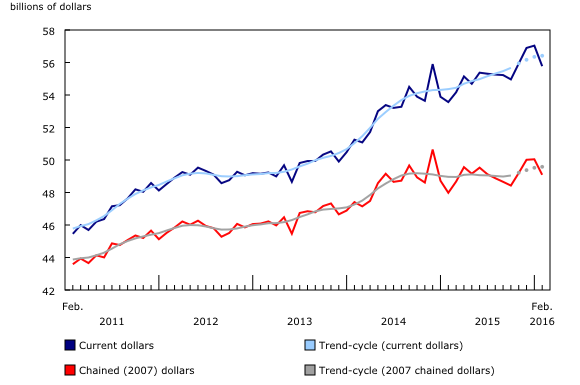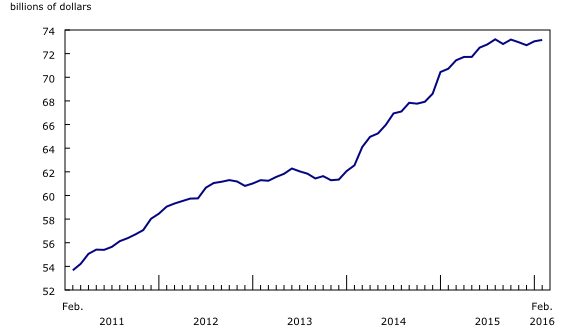Wholesale trade, February 2016
Archived Content
Information identified as archived is provided for reference, research or recordkeeping purposes. It is not subject to the Government of Canada Web Standards and has not been altered or updated since it was archived. Please "contact us" to request a format other than those available.
Released: 2016-04-20
$55.8 billion
February 2016
-2.2% 
(monthly change)
Wholesale sales decreased 2.2% to $55.8 billion in February after three consecutive increases. Lower sales were recorded in five of seven subsectors, accounting for 66% of total wholesale sales.
In volume terms, wholesale sales declined 1.9%.
Lower sales in five subsectors
The machinery, equipment and supplies subsector recorded the largest decline in dollar terms in February, decreasing 4.8% to $11.0 billion and more than offsetting the 4.1% gain in January. Every industry within the subsector recorded lower sales, led by the construction, forestry, mining, and industrial machinery, equipment and supplies industry (-11.5%). Decreases in exports and imports of industrial machinery, equipment and parts, and manufacturing sales of machinery were also recorded in February.
In the motor vehicle and parts subsector, sales decreased 3.5% to $10.4 billion, their lowest level in three months. All three industries in the subsector declined, led by the motor vehicle industry, down 3.6% to $8.0 billion, a second consecutive decrease. In February, there were lower imports and exports of motor vehicles and parts as well as lower sales by motor vehicle assembly plants.
Following a 2.5% increase in January, sales in the miscellaneous subsector declined 4.0% to $7.1 billion. The other miscellaneous industry (-7.7%) and the agricultural supplies industry (-6.1%) contributed to the decline.
In the building material and supplies subsector, sales decreased 1.8% to $7.6 billion, their lowest level since October 2015. The electrical, plumbing, heating and air-conditioning equipment and supplies industry contributed the most to the decline, decreasing 4.8% to $2.3 billion in February.
The personal and household goods subsector rose 1.4% to $7.9 billion on the strength of gains in the pharmaceuticals and pharmacy supplies industry (+2.9%), following two months of declines for the industry.
Sales decline in all but one province
Lower sales were recorded in nine provinces in February, led by Ontario and Saskatchewan.
In Ontario, sales declined for a second consecutive month, down 1.2% to $28.6 billion. The motor vehicle and parts subsector and the machinery, equipment and supplies subsector contributed the most to the decrease.
Sales in Saskatchewan fell 12.8% to $2.1 billion, their lowest level since August 2014. Declines were widespread across subsectors in this province, with the miscellaneous subsector being the largest contributor.
In Alberta, sales decreased 3.4% to $6.2 billion on widespread declines across subsectors. This second consecutive monthly decline brought sales in the province to their lowest level since September 2011.
Sales in Quebec decreased 1.6% to $10.1 billion, following six months of increases. Declines were recorded in a majority of the subsectors, with the miscellaneous subsector contributing the most to the decline.
Following a 3.9% gain in January, sales in British Columbia decreased 2.6% to $5.5 billion. The building material and supplies subsector led the decline.
Sales in Manitoba decreased 3.8% to $1.4 billion as the miscellaneous subsector and the motor vehicle and parts subsector led the declines.
Sales in the motor vehicle and parts subsector contributed the most to the decline in Nova Scotia, down 1.1% to $811 million.
Newfoundland and Labrador was the only province with higher sales in February. Following three consecutive declines, sales in this province were up 1.7% to $349 million, on the strength of higher sales in the food, beverage and tobacco subsector.
Inventories increase in February
Inventories rose 0.2% to $73.2 billion in February. Gains were recorded in three of seven subsectors, which together represented 61% of wholesale inventories.
In dollar terms, the largest gain was in the machinery, equipment and supplies subsector (+0.8%), its second consecutive increase.
The personal and household goods subsector (+0.2%) recorded a third consecutive gain, while the motor vehicle and parts subsector (+0.2%) increased for the first time in three months.
Inventories decreased 0.3% in the building material and supplies subsector, a second consecutive decline.
After reaching their highest levels on record in January, inventories declined in the food, beverage and tobacco subsector (-0.4%) and the miscellaneous subsector (-0.2%).
The inventory-to-sales ratio rose from 1.28 in January to 1.31 in February. This ratio is a measure of the time in months required to exhaust inventories if sales were to remain at their current level.
Note to readers
All data in this release are seasonally adjusted and expressed in current dollars, unless otherwise noted. For information on seasonal adjustment, see Seasonally adjusted data – Frequently asked questions.
Total wholesale sales expressed in volume are calculated by deflating current dollar values using relevant price indexes. The wholesale sales series in chained (2007) dollars is a chained Fisher volume index with 2007 as the reference year. For more information, see Sales in volume for Wholesale Trade.
The Monthly Wholesale Trade Survey covers all industries within the wholesale trade sector as defined by the North American Industry Classification System (NAICS), with the exception of oilseed and grain merchant wholesalers (NAICS 41112), petroleum and petroleum products merchant wholesalers (NAICS 412), and business-to-business electronic markets, and agents and brokers (NAICS 419).
For information on trend-cycle data, see the StatCan Blog and Trend-cycle estimates – Frequently asked questions.
Real-time CANSIM tables
Real-time CANSIM tables 081-8011, 081-8012 and 081-8015 will be updated on April 27. For more information, consult the document Real-time CANSIM tables.
Next release
Wholesale trade data for March will be released on May 19.
Contact information
For more information, contact us (toll-free 1-800-263-1136; 514-283-8300; STATCAN.infostats-infostats.STATCAN@canada.ca).
For analytical information, or to enquire about the concepts, methods or data quality of this release, contact John Burton (613-862-4878; john.burton@canada.ca), Manufacturing and Wholesale Trade Division.
- Date modified:



